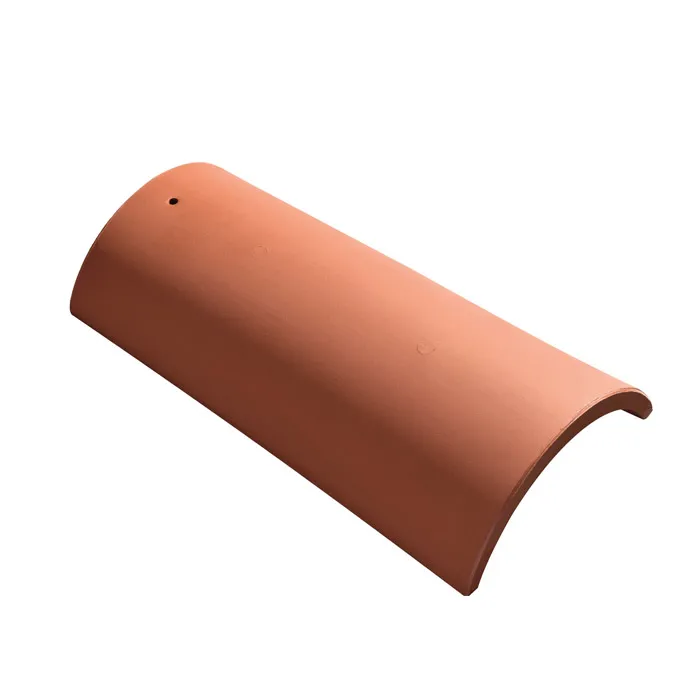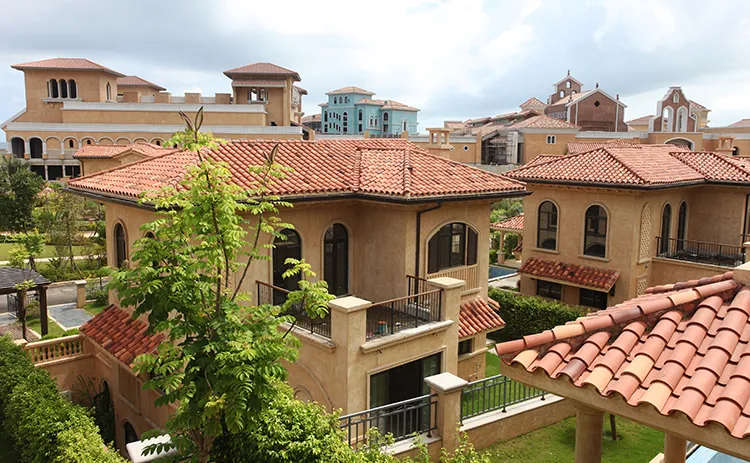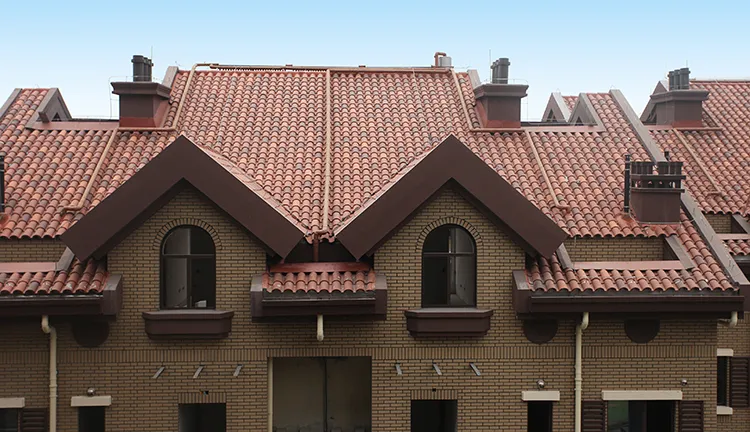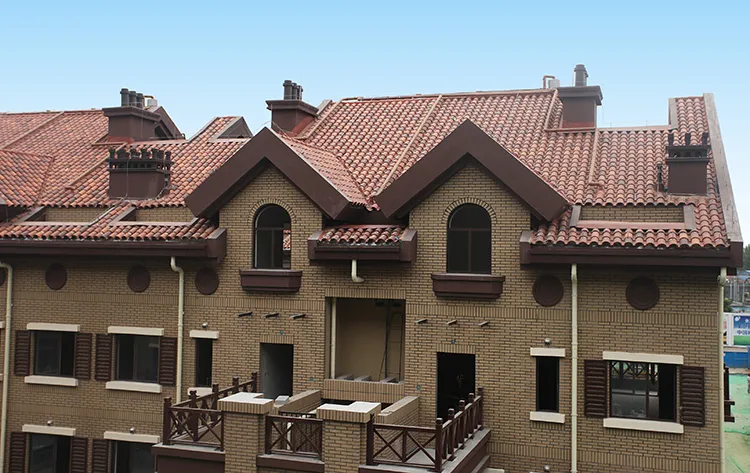Clay roof shingles have always been one of the most widely used roofing materials in global buildings due to their unique aesthetics, durability and environmental friendliness. However, to ensure the best performance of clay roof shingles, especially in terms of waterproofness, durability and load-bearing capacity, it is crucial to choose the right slope. The slope of laying clay roof shingles is not only directly related to the appearance and aesthetics of the roof, but also to the functionality and durability of the roof.
So, what is the minimum slope for laying terreal roof tiles? At what slope can clay tiles play their greatest advantages? This article will analyze in detail the minimum slope requirements for laying clay roof shingles, explore the various factors that affect the choice of slope, and provide professional advice to help architects, builders and homeowners make appropriate decisions.

What is the structure and characteristics of terreal roof tiles?
Before understanding the minimum slope for laying terreal roof tiles, we need to understand the basic structure and characteristics of clay roof shingles. Clay roof shingles are usually covered by a layer of clay tiles, which are built in an overlapping manner. The shape and design of each tile may vary depending on the region, style and manufacturer, but clay roof shingles usually present a wavy, curved or flat shape.
The advantages of clay roof shingles include:
● Strong weather resistance: Clay roof shingles can effectively cope with extreme climate conditions, including high and low temperatures, heavy rain, strong winds, etc., so it is often used on roofs in various climates.
● Good waterproofing: When clay roof shingles are laid correctly, they can effectively prevent rainwater from penetrating into the house and protect the house from water damage.
● Durable: Because terreal roof tiles are natural and durable, they have a long service life and relatively low maintenance costs.
● Strong aesthetics: Clay roof shingles have natural colors and rich textures, which can add beauty to the building.
● Environmental protection: Clay roof shingles are natural and environmentally friendly, meeting the standards of green buildings.
However, despite these significant advantages of terreal roof tiles, the choice of roof slope is crucial to ensure their long-term use and functionality.

What is the minimum slope for laying terreal roof tiles?
When laying clay roof shingles, the choice of the minimum slope is mainly determined by several factors, including waterproofing, drainage efficiency, the load-bearing capacity of the roof, and the design and material of the tiles. Different roof slopes directly affect the joints, sealing and overall waterproofing of the roof tiles.
1. How clay tiles work
Clay roof shingles mainly form a waterproof barrier through the overlapping effect between tiles. Each terreal roof tile is covered on the terreal roof tiles below, forming a layered effect. This overlapping design allows rainwater to flow quickly from the roof surface without accumulating on the tiles, thereby preventing water from penetrating into the lower roof layer.
On a flatter roof, water flows more slowly and tends to be trapped in the seams of terreal roof tiles, increasing the risk of water seepage. A roof with a larger slope can effectively increase the speed of water flow, speed up the drainage of water, and reduce the risk of water penetration. Therefore, in order to ensure the waterproof effect of clay roof shingles, the slope must be large enough to ensure that rainwater can be drained quickly.
2. Standards for minimum slope
According to industry standards and building specifications, the minimum slope for laying clay roof shingles is usually 30% (i.e. 7 degrees). This slope ensures that water can be discharged smoothly and prevents the joints between tiles from being eroded by water. If the slope is too small, the water flow rate slows down and water is easily accumulated, which leads to water seepage at the tile joints and reduces the waterproofness of the roof.
It should be noted that this slope requirement applies to general climatic conditions. In extreme weather or rainy areas, a larger slope may be required to ensure effective drainage of the roof.
3. The impact of too small a slope
If the slope of the roof is less than 30%, the waterproof performance of clay roof shingles will be greatly reduced. Since the water cannot be discharged smoothly, water may be trapped between the terreal roof tiles, resulting in:
● Water penetration: Water penetrates into the roof, which may cause dampness, mildew and other problems in the walls, ceilings and other places, and may even damage the structure of the house.
● Water accumulation and corrosion: Long-term water accumulation may cause corrosion and damage to the tiles, thus affecting the long-term service life of the roof.
Structural problems: Excessive water accumulation may increase the weight of the roof, affect the load-bearing capacity of the roof structure, and cause potential safety hazards.
4. The impact of excessive slope
Although a larger slope can ensure smooth drainage of water, a large slope may also cause some unnecessary problems. A too steep roof design may:
● Increase construction difficulty: A steeper slope increases the difficulty of roof construction, and more supporting structures may be required, increasing the cost of the project.
● Increase wind burden: A steep roof is easily affected by wind, which may blow off the tiles, especially in stormy weather, and may require stronger structural support.
● Appearance discomfort: A too steep roof may not meet the aesthetic requirements of the building and affect the overall appearance.
Therefore, choosing a reasonable slope is the key to ensure a balance between the waterproof effect of the roof and the aesthetics of the building.

Other factors affecting the choice of slope
In addition to waterproofness, choosing an appropriate slope also requires considering multiple other factors, including roof structure, climate conditions, terreal roof tiles type, and architectural design style.
1. Roof structure and design
Different roof structures may have different requirements for slope. For example, for designs with multiple roof angles and complex roofs, more sophisticated slope calculation and design are required to ensure that water flow at each angle can be discharged smoothly. In this case, the slope may need to be locally adjusted to meet the drainage needs of different roofs.
2. Climate conditions
Climate conditions are crucial to the choice of roof slope. In areas with high precipitation and strong winds, a steeper slope is usually required to ensure that terreal roof tiles can drain efficiently. In arid and rainless areas, the slope can be appropriately slowed down to reduce construction difficulty and engineering costs.
3. Tile type and design
Different types of clay roof shingles may have different requirements for slope. For example, traditional curved clay tiles overlap more than flat tiles, so they can effectively waterproof at lower slopes. Flat tiles, however, usually require a larger slope to ensure smooth water flow due to fewer joints. Therefore, when choosing the type of terreal roof tiles, the appropriate slope must be determined based on the design of the tile.
4. Architectural design style
Architectural design style is also an important factor affecting the choice of slope. Some architectural styles, such as traditional European-style buildings, often require steeper roof slopes, while modern-style buildings may tend to have a more gentle slope. Designers need to consider both the aesthetic effect and functional requirements of the building when designing the roof and choose a reasonable slope.

How to ensure the waterproof effect of clay roof tiles?
In order to ensure the best waterproof effect of terreal roof tiles, in addition to choosing the appropriate slope, you also need to pay attention to the following points:
● Ensure proper installation: During installation, terreal roof tiles should be properly docked to ensure that the overlapping parts are sealed. Improper installation may cause the joints between tiles to be too large or misaligned, causing water seepage problems.
● Choose high-quality tiles: High-quality terreal roof tiles have better sealing and wind resistance, and can effectively prevent water penetration.
● Regular maintenance: Check the roof regularly to ensure that no terreal roof tiles are damaged or loose. Replace damaged tiles in time to maintain the waterproof performance of the roof.
● Clean the drainage system: Keep the roof drainage system unobstructed and clean up debris that may accumulate in the drains or gutters to avoid water accumulation problems.
In the competitive world of building materials, Foshan Rongguan Glass Material for Building Co., Ltd. has emerged as a trusted supplier for quartz stone countertops, terrazzo flooring, and decorative terreal roof tiles. We pride ourselves on delivering products that blend durability with design versatility. With a 300,000-square-meter facility equipped with state-of-the-art machinery, our factory meets the growing demand for high-quality materials worldwide. Whether you need affordable pricing for bulk orders or customized designs for specific projects, Rongguan offers tailored solutions that meet your needs.

